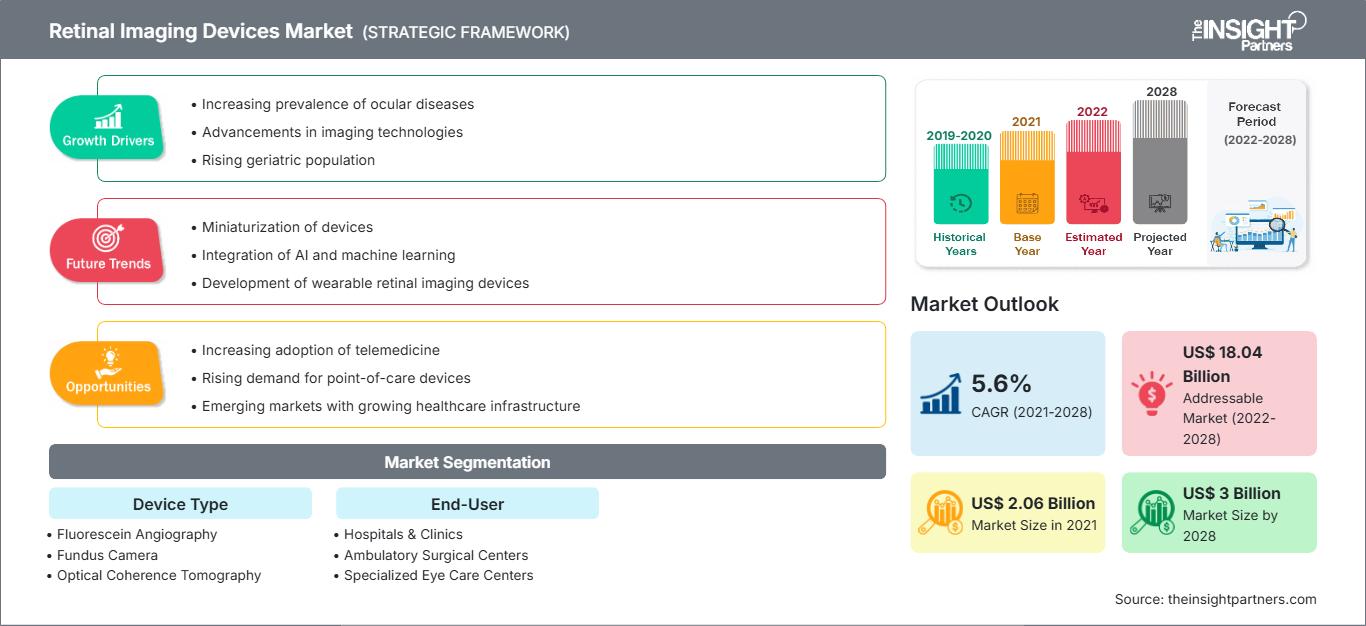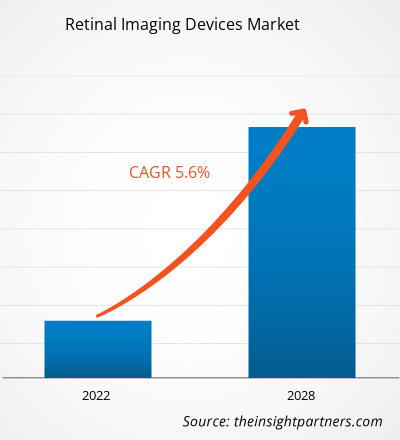Si prevede che il mercato dei dispositivi di imaging retinico raggiungerà i 3,00 miliardi di dollari entro il 2028, rispetto ai 2,06 miliardi di dollari del 2021; si stima una crescita a un CAGR del 5,6% nel periodo 2021-2028.
L'imaging retinico è una tecnica utilizzata per analizzare e diagnosticare le condizioni della retina di un paziente. I dispositivi di imaging retinico (RID) utilizzano sistemi di imaging ad alta risoluzione per acquisire immagini interne dell'occhio. L'immagine acquisita aiuta i medici della rete Virtual Private Network (VSP) a valutare lo stato di salute della retina, contribuendo all'individuazione e alla gestione di patologie oculari e di salute come diabete, glaucoma e degenerazione maculare, tra le altre.
Personalizza questo rapporto in base alle tue esigenze
Potrai personalizzare gratuitamente qualsiasi rapporto, comprese parti di questo rapporto, o analisi a livello di paese, pacchetto dati Excel, oltre a usufruire di grandi offerte e sconti per start-up e università
Mercato dei dispositivi di imaging retinico: Approfondimenti strategici

-
Ottieni le principali tendenze chiave del mercato di questo rapporto.Questo campione GRATUITO includerà l'analisi dei dati, che vanno dalle tendenze di mercato alle stime e alle previsioni.
La crescita del mercato dei dispositivi di imaging retinico è attribuita al migliore accesso degli oculisti alla retina, alle crescenti iniziative globali per la cecità e ai progressi tecnologici. Tuttavia, l'elevato costo dei dispositivi OCT ostacola la crescita del mercato.
Approfondimenti di mercato: Aumento della prevalenza delle malattie oculari
I dispositivi di imaging retinico sono ampiamente utilizzati per diagnosticare e trattare diverse patologie oculari, come la retinopatia diabetica, la degenerazione maculare legata all'età, il glaucoma, il melanoma oculare e lievi problemi di vista. Inoltre, in tutto il mondo, la preoccupazione per la cecità o i problemi di vista sta crescendo in modo significativo. Secondo i dati pubblicati dall'Organizzazione Mondiale della Sanità (OMS) nell'ottobre 2021, quasi 2,2 miliardi di persone convivono con un deficit visivo o cecità. Di questi, circa un miliardo di casi di deficit visivo può essere prevenuto con una diagnosi e un trattamento adeguati. Questo miliardo di persone presenta diversi problemi oculari correlati a un deficit visivo da lontano moderato o grave o alla cecità. Le tecnologie diagnostiche basate sulle immagini hanno iniziato a offrire una crescita senza precedenti nelle patologie oculari basate su set di dati morfologici. Si prevede che tale fattore contribuirà al mercato dei dispositivi di imaging retinico nel periodo di previsione.
Approfondimenti basati sul tipo di dispositivo
In base al tipo di dispositivo, il mercato globale dei dispositivi di imaging retinico è stato segmentato in angiografia con fluoresceina, fundus camera e tomografia a coerenza ottica. Il segmento delle fundus camera ha detenuto la quota di mercato maggiore nel 2021. La fotografia del fondo oculare si è evoluta dai flash elettronici alle fotocamere basate su smartphone, fino al più recente kit portatile per l'esame oculistico (PEEK). PEEK è un'applicazione basata su smartphone per un esame oculistico completo. Il vantaggio di queste fotocamere è che anche un non oculista può scattare foto e, con un po' di formazione, valutarle. Tuttavia, si prevede che il segmento della tomografia a coerenza ottica registrerà il CAGR più elevato del mercato, pari all'8,1%, durante il periodo di previsione. La tomografia a coerenza ottica consente la valutazione di diversi livelli di ischemia maculare non diagnosticati con l'imaging primario. La tecnica è utilizzata come standard per le modalità di imaging oculistico.
Approfondimenti basati sull'utente finale
In base all'utente finale, il mercato globale dei dispositivi di imaging retinico è segmentato in ospedali e cliniche, cliniche specialistiche, centri di assistenza ambulatoriale e altri. Il segmento ospedali e cliniche ha detenuto la quota maggiore del mercato nel 2021 e si prevede che i centri oculistici specializzati registreranno il CAGR più elevato del mercato, pari al 6,6%, durante il periodo di previsione.
Mercato dei dispositivi di imaging retinicoLe tendenze regionali e i fattori che influenzano il mercato dei dispositivi di imaging retinico durante il periodo di previsione sono stati ampiamente spiegati dagli analisti di The Insight Partners. Questa sezione illustra anche i segmenti e la geografia del mercato dei dispositivi di imaging retinico in Nord America, Europa, Asia-Pacifico, Medio Oriente e Africa, America Meridionale e Centrale.
Ambito del rapporto di mercato sui dispositivi di imaging retinico
| Attributo del rapporto | Dettagli |
|---|---|
| Dimensioni del mercato in 2021 | US$ 2.06 Billion |
| Dimensioni del mercato per 2028 | US$ 3 Billion |
| CAGR globale (2021 - 2028) | 5.6% |
| Dati storici | 2019-2020 |
| Periodo di previsione | 2022-2028 |
| Segmenti coperti |
By Tipo di dispositivo
|
| Regioni e paesi coperti |
Nord America
|
| Leader di mercato e profili aziendali chiave |
|
Densità degli operatori del mercato dei dispositivi di imaging retinico: comprendere il suo impatto sulle dinamiche aziendali
Il mercato dei dispositivi di imaging retinico è in rapida crescita, trainato dalla crescente domanda degli utenti finali, dovuta a fattori quali l'evoluzione delle preferenze dei consumatori, i progressi tecnologici e una maggiore consapevolezza dei benefici del prodotto. Con l'aumento della domanda, le aziende stanno ampliando la propria offerta, innovando per soddisfare le esigenze dei consumatori e sfruttando le tendenze emergenti, alimentando ulteriormente la crescita del mercato.

- Ottieni il Mercato dei dispositivi di imaging retinico Panoramica dei principali attori chiave
Approfondimenti regionali
In base alle regioni, il Nord America ha rappresentato la quota maggiore nel 2021 e si prevede che seguirà un trend simile nel periodo di previsione. Si prevede che la regione Asia-Pacifico registrerà il tasso di crescita più elevato nel periodo di previsione. L'applicazione dell'intelligenza artificiale (IA) e del sistema di apprendimento profondo (DLS) per migliorare la copertura dello screening a Singapore dovrebbe sostenere la crescita regionale nei prossimi sette anni.
Il lancio e l'approvazione dei prodotti sono strategie comunemente adottate dalle aziende per espandere la propria presenza globale e il proprio portafoglio prodotti. Inoltre, gli operatori del mercato dei dispositivi di imaging retinico si concentrano sulla strategia di partnership per espandere la propria clientela, il che, a sua volta, consente loro di mantenere il proprio marchio in tutto il mondo.
In base alla tipologia di dispositivo, il mercato dei dispositivi di imaging retinico è suddiviso in angiografia con fluoresceina, fundus camera e tomografia a coerenza ottica. In base all'utente finale, il mercato è segmentato in ospedali e cliniche, centri chirurgici ambulatoriali, centri oculistici specializzati e altri utenti finali. In base all'area geografica, il mercato dei dispositivi di imaging retinico è segmentato in Nord America (Stati Uniti, Canada e Messico), Europa (Regno Unito, Germania, Francia, Italia, Spagna e resto d'Europa), Asia-Pacifico (Cina, Giappone, India, Australia, Corea del Sud e resto dell'Asia-Pacifico), Medio Oriente e Africa (Emirati Arabi Uniti, Arabia Saudita, Sudafrica e resto del Medio Oriente e Africa) e Sud e Centro America (Brasile, Argentina e resto del Sud e Centro America).
Alcuni dei profili aziendali elencati nel nostro ambito di ricerca includono, tra gli altri, Carl Zeiss Meditec, Revenio Group Oyj, Nikon Corporation, Optomed, Topcon Corporation, Imagine Eyes, Epipole Ltd, Forus Health Pvt Ltd, Eyenuk Inc e Phoenix Technology Group LLC.- Analisi storica (2 anni), anno base, previsione (7 anni) con CAGR
- Analisi PEST e SWOT
- Valore/volume delle dimensioni del mercato - Globale, Regionale, Nazionale
- Industria e panorama competitivo
- Set di dati Excel
Report recenti
Testimonianze
Motivo dell'acquisto
- Processo decisionale informato
- Comprensione delle dinamiche di mercato
- Analisi competitiva
- Analisi dei clienti
- Previsioni di mercato
- Mitigazione del rischio
- Pianificazione strategica
- Giustificazione degli investimenti
- Identificazione dei mercati emergenti
- Miglioramento delle strategie di marketing
- Aumento dell'efficienza operativa
- Allineamento alle tendenze normative






















 Ottieni un campione gratuito per - Mercato dei dispositivi di imaging retinico
Ottieni un campione gratuito per - Mercato dei dispositivi di imaging retinico